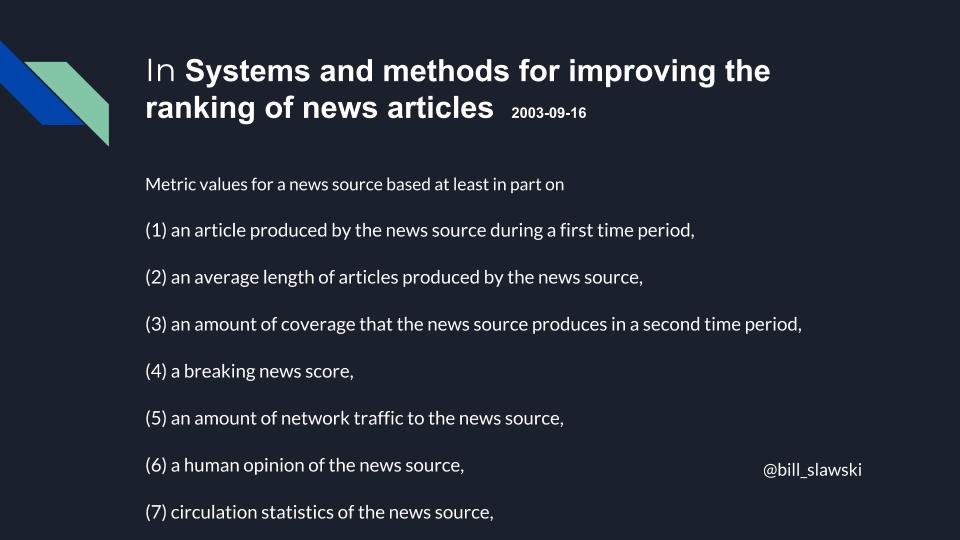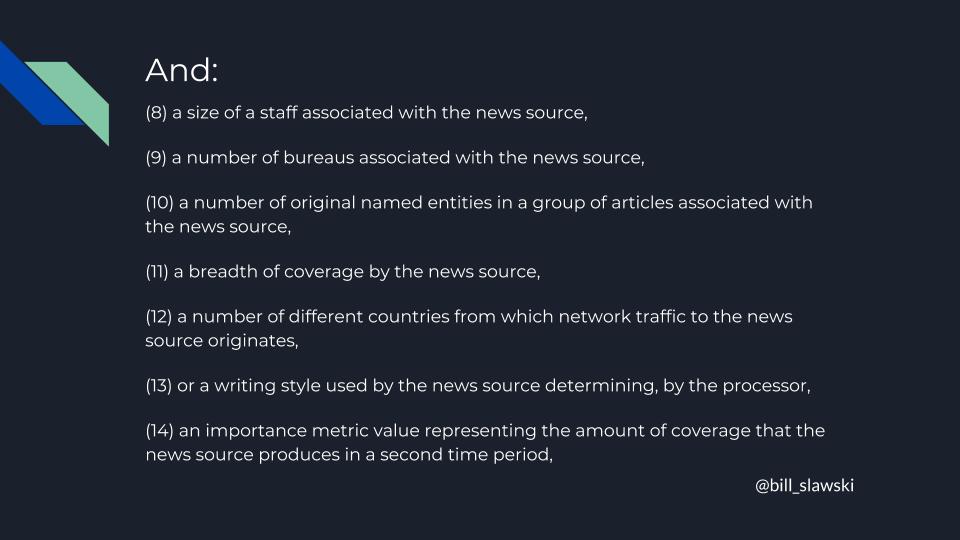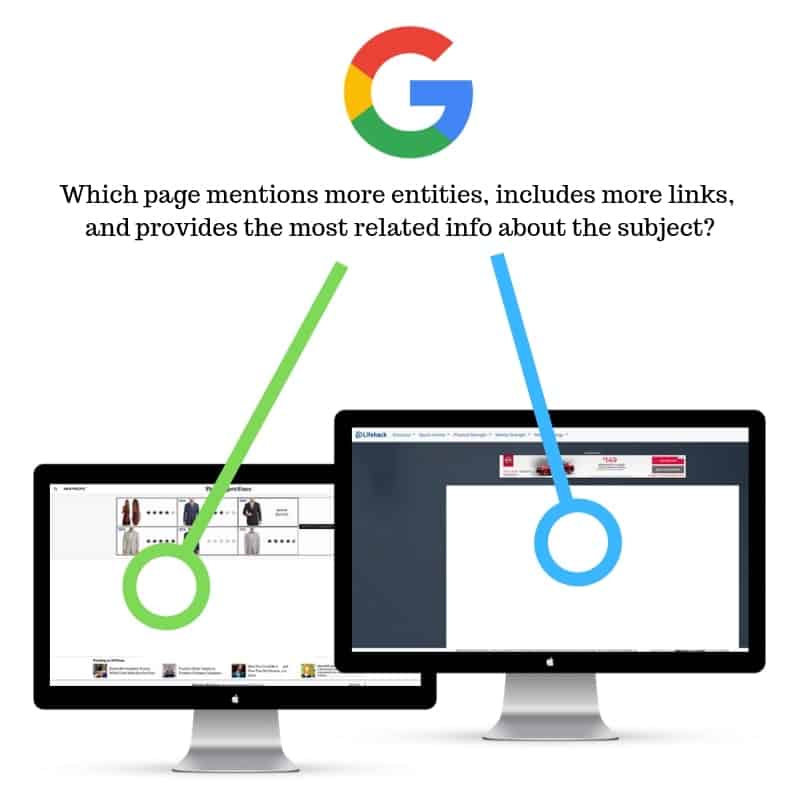What You Can Learn From Google Search Patents & Voice Search
For most publishers, keeping up with Google’s algorithm changes is critical for maintaining traffic and sustaining revenue. Understanding how Google Search works is probably one of the most valuable ways of keeping your website on the right path as shifts in the algorithm happen. Unfortunately, a large part of this is a black box.
Over time, Google has shared more and more about how Google Search actually works. There are the fundamental parts that are not hidden behind a locked box — like how a search engine generally works by crawling the web and indexing pages — and then there are parts about how Google ranks those indexed websites according to user queries that is subject to far more mystery.
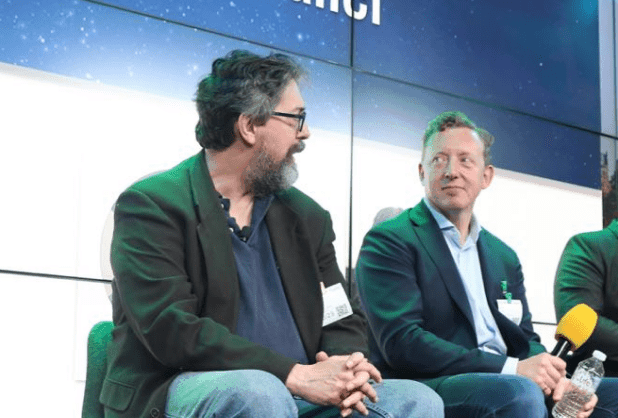
Director of SEO Research for Go Fish Digital, Bill Slawski, recently provided some unique insight into this typically hidden portion of how Google Search operates when he spoke on Google’s search patents and voice search updates at Pubtelligence, hosted at Google offices in London.
Slawski is a leading expert on Google’s patents and has written about them quite a bit on his blog SEOByTheSea. In his discussion at Pubtelligence, Bill relayed a few ways to better understand how Google is discovering and ranking relevant content.
Here, you can watch his full presentation. I’ve also summarized some of his most interesting and helpful takeaways in the text below.
What Can We Gain Studying Google’s Patents?
According to Bill, Google’s patents are worth studying because they provide clues as to what Google is currently working on improving in Search. This means that by observing Google’s patents and patent continuations, you can potentially better optimize your website, or it’s content, long-term to align with what Google will likely prioritize when ranking websites.
Bill says that Google will release new patents but often elects to update their old ones instead. When patents are updated, all of the information from the previous patent is repeated and then new claims are tacked on. These updated patents allow you to stay up-to-date on what Google has already deemed important.
The Google Patents That Bill Thinks Are Relevant Right now
Bill started with an older Google patent that he believes provides some unique insight into how Google looks at entities.
Google released a patent in 2003 that was designed by inventor Krisztian Balog, professor of computer science and visiting researcher for Google. The original patent had roughly 14 items in the claims section that described what a news agency is, how they work, and what makes a valuable one; such as a number of international bureaus in cities around the world and those with high print subscription rates.
As most news agencies’ focus changed to online content rather than printed newspapers in the following decade, international bureaus and print subscription rates were no longer an indication of a successful news publication.
In 2015, Google came out with a new version of this patent relaying that they would now look at links and how many entities are mentioned in a news article to measure success for news publications.
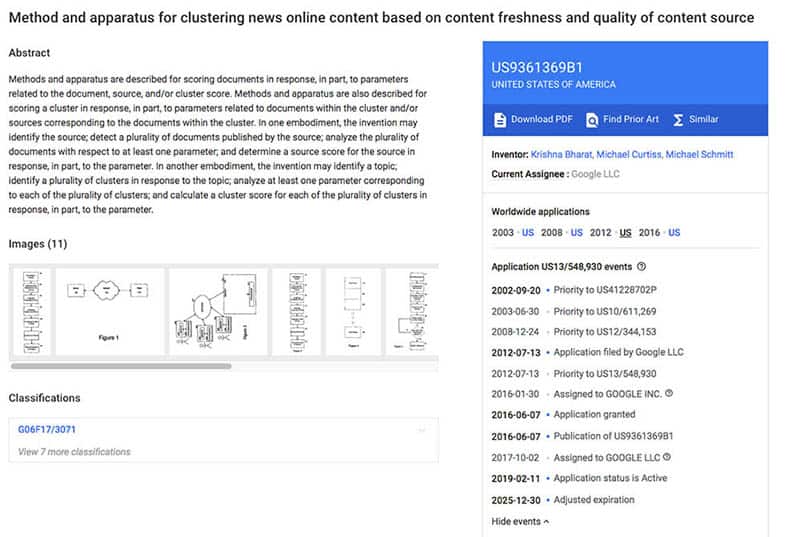
Another patent Bill discussed was a patent released in 2002 and updated in 2016. This patent looks at how search results are clustered by topic. Google will serve the most representative content to its searchers, meaning the freshest and most-updated content will be served higher.
Why this matters: Bill claims that this is setting the stage for how Google, not only looks at news content but how it looks at all entities and how they relate to each other in a way that searchers may find relevant. This is partially the framework for how Google can determine which content may be providing more in-depth coverage or details about a subject than others.
Sorting Through All The Noise With Google
Sometimes, Google will publish a long list of related patents. Bill says that since Google is putting a lot of time, energy, and resources into creating these long strings of related patents, it’s a good indication that the topic of the related patents is important to the company.
Right now, Google has a series of 20 patents on phrase-based indexing and Google’s approach to showing the meaning of pages.
Phrase-based indexing takes phrases and semantic themes occurring on multiple pages that rank highly for a term, groups these together, and then understands their relationship to one another. This information is used to improve both relevancy scores and link analysis, and decrease spam.
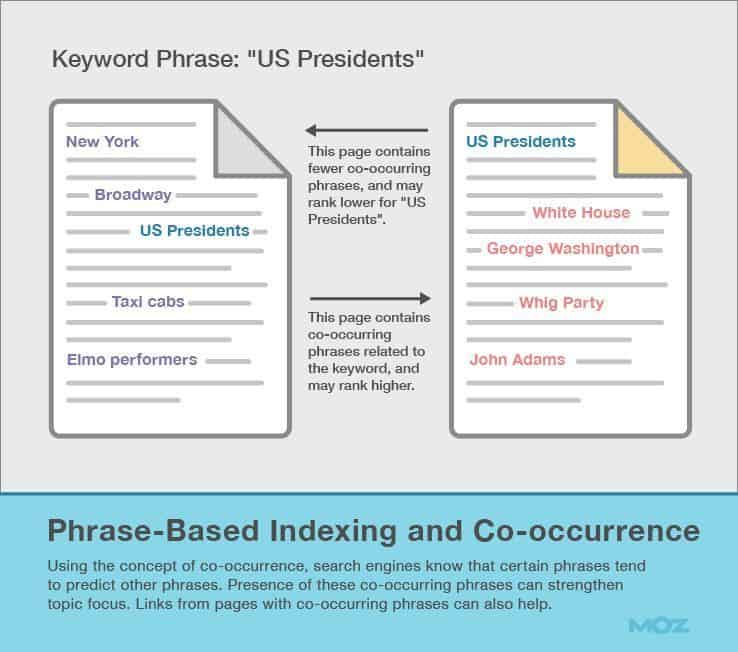
If a page has content about US Presidents, then it likely contains words like White House, George Washington, Whig Party, and John Adams. Words like that can indicate what the topic of the page may be, and Google uses these groupings of words to create keyword tables for documents. These documents then allow for quicker and more accurate search results.
Follow the experts and patent filers at Google
Bills says that if you want to keep tabs on upcoming continuation patents, look up the author or inventor of the patent and check for any updates through their LinkedIn or a web search. Since they are the closest person to the patent, they will likely have the most recent information and extensive knowledge on the changes.
You can also search for speeches or podcasts from people within the industry, such as Senior Webmaster Trend Analyst for Google, John Mueller.
If you were to take action on the examples Bill gave above, he says you would also want to research upcoming Google patent releases, updates, and additions to patent series. Even if there aren’t any upcoming patents, he claims that you could find which patents have received the most updates or were most recently updated.
Bill says that this will give you an idea of what Google has focused on in the past and what they will prioritize in the near future. Find the authors or inventors of the patents and see if they have published anything recently about the patent.
What is the takeaway from the patent above?
You want to generate high-quality, updated content, and mention more links and entities than other publishers to be considered the most comprehensive or authoritative on a particular topic. This will show Google that you remain current on — and have expertise in — a topic in a way other publishers may not.
Pay attention To Entities, Schema, and Voice Search
Bill talked about how this is all connected with the way Google is moving a lot of their current initiatives.
In optimizing for Google’s patent updates, he says it’s important to keep both your entities and schema relevant alongside your content. This includes adding machine ID entities.
In 2010, Google bought Metaweb, which included a massive database called FreeBase. Google previously gave machine IDs to different entities using a long string of letters and numbers through Freebase.

Bill’s example: Every time there was an online article published about Arnold Schwartzenager, it was marked with a machine ID and then this signaled to serve all content concerning Arnold Schwartzenager marked with that ID.
What Bill says to do with this info: Take a look at your site’s entities and then the entities of its individual pages. To appear in search results relevant to your content, you have to specify which entity on the page the article is about and optimize for key entities within your content.
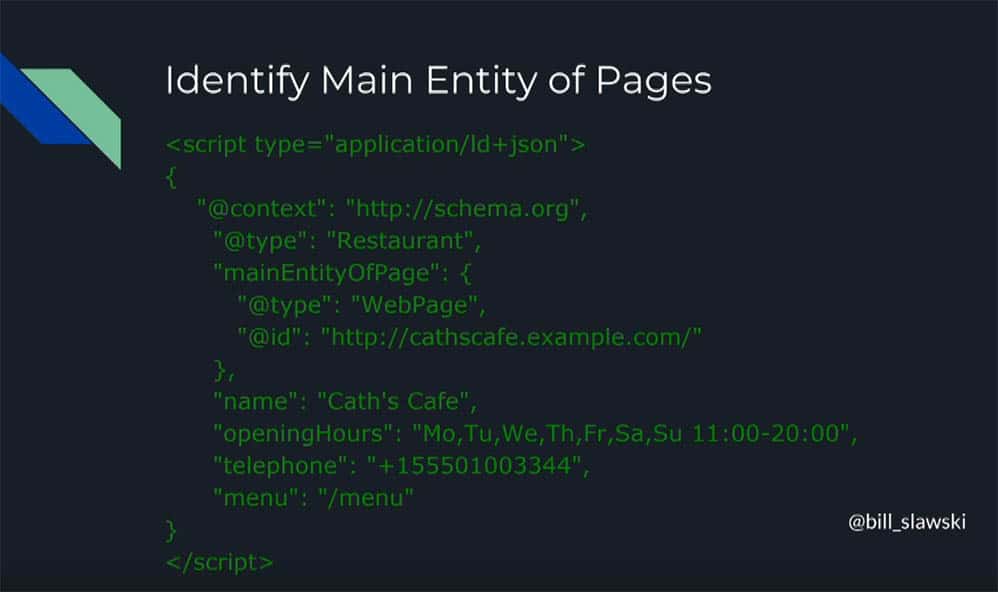
What this looks like in the real world
For example, Bill worked on a website for an apartment building that was four pages long. However, the site didn’t include a lot of information about the specifics of the apartments, even though they were in a prime location in Washington D.C.
Once entities were added and optimized for things like location, and access to free museums, the apartments sold very quickly.
What Bill did: He added references, links, media, and Schema mark up related to his subject to highlight that these pages were the most comprehensive and most relevant on the topic.
Optimizing For Voice Search with Speakable Schema
While your entities may now be optimized for web searches through a computer or mobile device, it is becoming increasingly important to also optimize your entities for voice search through smart assistants like Alexa, Google Home, and Echo.

To optimize for entities through voice search, Bill says you should be adding speakable Schema mark up to your content.
Speakable Schema mark up is a way to let smart assistants identify answers within your content to questions people may audibly ask a smart speaker. New speakable schema is being introduced on a regular basis, so your Speakable Schema should be adjusted frequently.
A way to differentiate yourself from other publishers in implementing Speakable Schema is to optimize for things like prosody in voice search through JSON-LD. If you are currently not using JSON-LD, Bill says you should be.
Google currently does machine learning on prosody but may favor results with prosody already included. Additionally, by using schema, you’re taking advantage of a database of information that Google will search before it searches through the index of web content, according to Bill.
Optimizing your Speakable Schema
Bill says that if you would like to optimize your Speakable Schema for prosody, start by speaking your answers to see how they sound out loud rather than reading them silently. Speaking your content will make you more aware of important speech patterns, like hyphens, emphasis, or prosody. Consider something like the unrhymed iambic pentameter style of Romeo and Juliet:

Most poetry needs to be read in a specific manner or with particular emphasis. Many parts of speech outside poetry also have specific nuances and it’s important to be careful and plan ahead for accents and emphasis with Speakable Schema.
How to leverage Bill’s knowledge on your site
Below are the tips Bill provided to help keep your content relevant and in-line with Google’s existing patents.
- Study Google’s new patents and any updates to old ones.
- Stay current on patent updates and Google’s direction by following experts that work at Google or authors of their patents online.
- Look for any talks, podcasts, blogs, or announcements they make.
- Make sure you have a lot of entities in your content and that these entities are up-to-date.
- Consider adding machine ID entities.
- Add Speakable Schema mark up to your site. Slawski recommends using JSON-LD to optimize for things like emphasis, hyphens, and prosody.
- Speak your content out loud and update words, phrasing, and schema markups so it sounds more natural if it were spoken out loud by a smart assistant.
Google will never show their cards all at one time, but you can better position yourself by following the advice of people like Bill.
For more, follow Bill Slaski on Twitter.
Questions? Comments? Concerns? Leave a comment below and I will do my best to answer your questions or direct you to more information.


